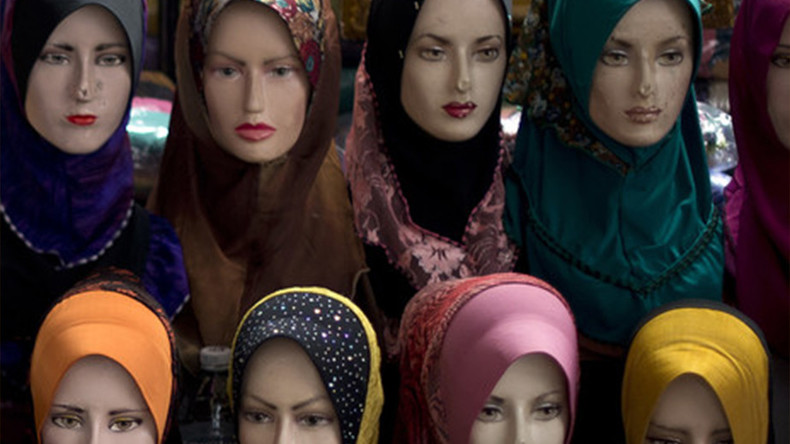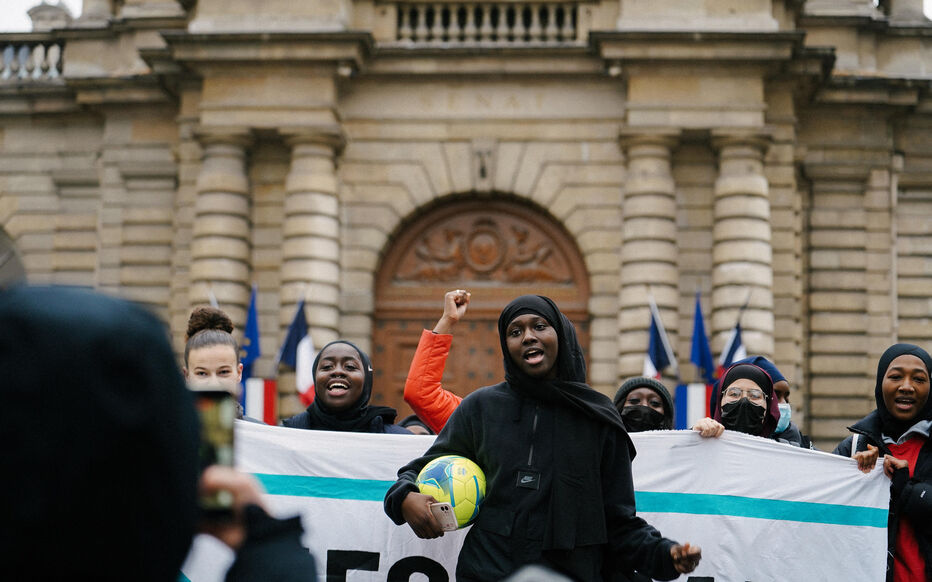In a new instalment of Germany’s long-running judicial battles over the hijab, the country’s highest court has in a new verdict upheld the legislator’s right to prohibit Muslim women from wearing the Islamic headcovering in certain circumstances.
Jurisprudence of the Constitutional Court
The Federal Constitutional Court (Bundesverfassungsgericht) rejected the application for interim relief filed by a junior lawyer from the state of Hesse working at a local court. Her employer, referring to a 2007 ministerial decree, had refused to let her wear the hijab when interacting with the public in an official role.
The Court’s decision appeared to be a reversal on a previously more concessionary interpretation of legal texts, and a turn to a more categorical upholding of a quasi-laic principle of state neutrality. In previous rulings, the Court had invalidated a blanket ban on headscarves worn by teachers at public schools and also rejected demands to outlaw the headscarf at public kindergartens.
“The sight of other religious convictions”
Yet while the Court had stated in its verdict on the kindergarten case that no one had a constitutional right to “be spared the sight of other religious or ideological confessions of faith”1, the present judgement seems to be based at least partly on the exact opposite reasoning. In somewhat convoluted phrasing, the judges assert that
it appears understandable if persons involved in a trial feel violated in their right to remain untouched by the cultic actions of a faith they do not espouse if they are subjected to the unavoidable compulsion of having to lead a lawsuit under the involvement of state representatives who identifiably project their religious or ideological convictions to the outside.2
In other words, at least in the sensitive domain of the justice system, people do have the right to be spared the sight of other religious convictions.
A crossroads for feminism
The significance of the verdict is, of course, not simply juridical: whilst phrased in the arcane language of Germany’s specific legal doctrine dealing with the relationship between Church (or religion more generally) and state – the so-called Staatskirchenrecht – the import of the judges’ decision lies in the ways in which it touches upon the place allocated to Islamic religiosity and Muslim women in the German public sphere.
In this context, the issue of the hijab regularly becomes a crossroads for progressive politics. Most notably, as Meredith Haaf writes in a thoughtful article for the Süddeutsche Zeitung newspaper3 – translated into English here – feminism continues to struggle over its positioning vis-à-vis the Muslim headscarf.
Combatting ‘sexualisation’
Internationally, influential NGO Terre des Femmes recently called for a global ban on hijabs for underage girls – a move that Haaf identifies as part of “the discursive stoking of discrimination against a section of the population”.
Terre des Femmes argues that the headscarf stigmatises girls and women as “seductresses and sexual beings”. Yet even if Muslim parents should indeed be acting upon this rationale, Haaf points out that many non-Muslims do the same by making their (often pre-pubescent) daughters wear bikini tops or by dressing them in ostentatiously ‘girlish’ clothing. Whether ‘oriental’ sexualisation is a more powerful force than its ‘occidental’ counterpart is thus far from clear.
Headscarf and patriarchy
Many feminists have nevertheless picked up upon the headscarf as the prime symbol and tool of patriarchal oppression in our age. In this context, a number of feminists have not shied away from entering a de facto alliance with the populist right.
In Germany, only the openly Islamophobic AfD party has called for a ban on the hijab such as the one demanded by Terre des Femmes. Needlessly to say, the AfD also supports a curtailment of women’s reproductive rights and a strengthening of the traditional family model – hardly an agenda that Western feminists have traditionally espoused.
Feminism’s rightward turn
Haaf takes particular aim at Emma, the long-standing leading German feminist publication. Founded by Alice Schwarzer, dominant persona of the German feminist movement, Emma’s editorial line (as well as Ms. Schwarzer’s personal politics) has shifted sharply to the right on matters concerning Islam.
Especially following the mass sexual assaults by predominantly North African men on New Year’s Eve 2015/2016 in Cologne, Schwarzer became very vocal in her description of Islam as a violent and inherently patriarchal ideology. In 2017, Schwarzer published an edited volume entitled The Shock: The New Year’s Eve of Cologne. In this work, Schwarzer and her co-authors assert that sexual violence is based on and legitimised (even called for) by the Qur’an.
‘Islamic feminism’
For her positioning Schwarzer has received harsh criticism from a feminist perspective. Khola Maryam Hübsch, journalist, Muslim activist, and author of the book Freedom under the Veil: What Islam Can Add to a Truly Emancipated Image of Women attacked Schwarzer for replicating the discourses and argumentative patterns employed by misogynistic Islamist extremism.4
Hübsch decried the fact that interventions such as Schwarzer’s essentialise ‘Islam’ or ‘the Qur’an’ and in this way “torpedo the attempts of all those Muslims who don’t tire of pointing to the obvious: particular verses need to be interpreted in textual and historical context. They must not be abused selectively for egoistically motivated behaviour.”5
Clashing feminisms
In many respects, Hübsch’s comments are expressive of a self-consciously ‘Islamic’ feminism, represented in Germany by voices such as Kübra Gümüsay. Islamic feminists highlight the ways in which mainstream feminism has – in their view – sidelined Muslim women by denying them agency and by conceptualising them as passive objects in need of saving.
Yet Hübsch’s account stressing the possibility of uniting feminism and the hijab is, of course, far from uncontested. Other Muslim commentators strike a very different note. Activist Zana Ramadani, author of the book The Veiled Danger, accuses mainstream feminism of having become politically correct and complacent. Ramadani sees Gümüsay and others as using accusations of Islamophobia and racism in order to silence critical voices raising uncomfortable questions about the nature of Islamic religiosity.6
Reverting to ad hominem attacks against Islamic feminists, Ramadani asserts that “these ignorant headscarf women are part of an Islamist lobby that through trickery has managed to obtain the solidarity of not only leftist feminists. They have all been hoodwinked by the Muslim fake-feminists such as Gümüsay”.7
The different meanings of the hijab
Thus, both sides castigate one another as having undermined feminism’s progressive credentials. In spite of the often lacklustre nature of the arguments employed – especially on the part of those blindly accusing headscarf-wearing women and their defenders of complicity with terrorism – neither side is necessarily completely wrong: the hijab may be imposed as an oppressive garment; yet it may also be freely chosen.
Thus, what is often difficult to understand and appreciate for both sides is the polyvalence of the hijab as a symbol. Those feminists who only conceive of the hijab as a symbol and a tool of domination fail to accept the fact that women may choose to wear the headcovering of their own accord. Those who see it as a potentially liberating object fail to see that it is at times violently imposed.
Religious obligations
Another facet of the problem is, however, even more difficult to conceptualise. Religious precepts are – at least in their traditional understanding – not based on free-wheeling ‘individual choice’ but on a communal tradition that is perceived as binding on the individual. To give but one example: Jewish and Muslim parents circumcise their male offspring – without the child having much of a say in it.
In a highly remarkable verdict in 2012, a German court condemned this practice as violating the child’s right to bodily integrity. While the legislator in Berlin quickly passed a law creating a loophole that allowed for the continued legality of religiously motivated circumcision of boys, the underlying point still stands: free individual choice and the belonging to a religious community may frequently clash.
The hijab as the norm
The same could quite well apply to many women wearing the hijab: it is true that an increasing number of women particularly in Western societies might make the individualistic choice to wear the Muslim headcovering. Yet in many cases, they will wear it because their families and their (Muslim) environment have signalled them that this is “the way things are to be done” in the community.
In many respects, Islamic feminists and their feminist antagonists both argue from the standpoint of a radical, individualistic choice: the former assert that Muslim women ‘choose’ the headscarf; the latter claim that Muslim women should be enabled to become true individuals by abandoning the garment.
Communal obligations vs. individual choice
Neither side tackles the much harder question concerning the place of communal obligations in an increasingly individualised society. Does it per se make people ‘unfree’ in a relevant way if they conceive of themselves as part of a religious community that is seen as imposing certain rules that go unquestioned by the community’s individual members and that thus curtail individual choice?
The framers of Germany’s Basic Law did not seem to think so: in their Staatskirchenrecht, they enshrined far-reaching guarantees for citizens to be able to belong to religious communities and to project their communal affiliations and beliefs to the outside, including in the public sphere. Yet as the recent verdicts given by Germany’s top courts reveal, the renegotiation and actualisation of these foundational principles in today’s context continues to be a challenge – especially in relation to Islam.
Sources
http://www.spiegel.de/karriere/eilantrag-gegen-kopftuchverbot-juristin-scheitert-vor-gericht-a-1155852.html ↩
http://www.bundesverfassungsgericht.de/SharedDocs/Pressemitteilungen/DE/2017/bvg17-055.html ↩
http://www.sueddeutsche.de/kultur/debatte-tuch-oder-tussi-1.3585227 ↩
http://cicero.de/kultur/koelner-silvesternacht-so-hilft-alice-schwarzer-den-islamfeinden-der-afd/60902 ↩
http://cicero.de/kultur/koelner-silvesternacht-so-hilft-alice-schwarzer-den-islamfeinden-der-afd/60902 ↩
http://cicero.de/kultur/islam-und-frauenrechte-pseudo-feministinnen-mit-kopftuch ↩
http://cicero.de/kultur/islam-und-frauenrechte-pseudo-feministinnen-mit-kopftuch ↩






